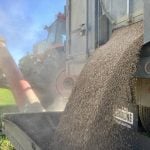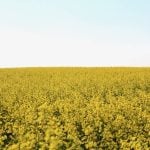JoAnne Buth, Canola Council
“Our 2008 crop was a record harvest. With record prices. A record crush. And record exports.”
The canola race is heating up.
Mons anto Canada broke ground on a $10-million research facility at the University of Manitoba last Monday, becoming the third company to announce a major expansion in canola research and development on the Canadian Prairies in as many weeks.
Ryan Baldwin, Monsanto’s lead researcher for seed and traits, said canola has joined corn, soybeans, cotton, along with wheat and rice on the company’s list of core crops the company is committed to helping farmers produce more with less by the year 2030.
Read Also

Hail research hopes to benefit potato growers
Alberta research scientist measures hail storm and heat dome affects on potato crops
He said Monsanto, which produces the DeKalb line of canola hybrids, has been aggressively increasing its investment in canola over the past five years, with research and development of between $20 million to $30 million annually.
“Certainly we are encouraged about the opportunity to bring new trait technologies such as yield, drought tolerance and nitrogen-use efficiency to canola and canola growers. And we are excited about the potential our research pipeline holds for delivering the products farmers have told us will make a difference on the farm,” he said.
The 29,000-square-foot facility expected to be fully operational by late 2010 will be used for line development breeding, breeding support functions, laboratory facilities for quality monitoring, doubled haploid breeding and plant pathology.
Monsanto also announced it is investing an estimated $3 million upgrading the company’s research facilities at its farm near Saskatoon.
Bayer expands in Saskatoon
Last week, Bayer CropScience, which sells the InVigor Hybrid line of canola varieties, celebrated the opening of its newly upgraded $15-million laboratories and greenhouses near Saskatoon.
“This is an historic day that’s all about driving canola forward through innovation,” said Kamel Beliazi, newly appointed president and CEO of Bayer CropScience Canada. “Not only is this a global-scale investment with international attention and impact, it highlights the importance of canola as a Canadian success story.”
The 50,000-square-foot facility includes more than 8,000 square feet of air purity-controlled greenhouse space, phytotron rooms and the host of modern lab facilities. It brings the Bayer CropScience global canola-breeding program together in one facility for the first time.
“When we say it’s our new centre of innovation, our choice of words is very deliberate,” said Garth Hodges, global canola business manager for Bayer CropScience. “This isn’t just a typical breeding centre or research farm.
“These new phytotron and greenhouse facilities allow an exponential leap in our plant-breeding efficiency because we can grow four generations of canola plants in a single year under very effective conditions of isolation to bring new innovation faster to the market. This will also afford us the opportunity to develop products for different market segments, including specialty oils,” explained Hodges.
Cargill also expands
And on July 17, Cargill opened its newly expanded speciality canola research and production centre in Aberdeen, Saskatchewan.
The research and production centre opened in late 2008 and will allow Cargill to centralize its hybrid breeding program, while giving growers and customers a state-of-the-art facility for furthering knowledge in canola production, the company said in a release.
The Cargill Specialty Canola Oils Research and Production Centre will be part of Cargill’s research farm, located about 50 kilometres from Cargill’s canola crush facility in Clavet, Saskatchewan. The research farm supports Cargill’s specialized hybrid breeding and production trials located across Western Canada, with a focus on developing high-yielding agronomic traits and the next generation of output traits.
“Cargill is committed to serving the entire supply chain, by providing high-yielding canola hybrids to farmers that ultimately result in oils with zero grams trans fats and lower saturated fat for our customers and the consumers they serve,” said Jenny Verner, president, Cargill Specialty Canola Oils.
The fact that Canada’s Cinderella crop is attracting so many suitors is good news for president of the Canola Council of Canada. “We’ve always said we need to be big enough to attract research and development dollars in order to remain competitive,” JoAnne Buth said in an interview recently.
She noted it has been a continued commitment to research that has brought canola along from its birth in the 1970s as a collaborative effort between plant breeders at the University of Manitoba and the University of Saskatchewan to a $14-billion industry in Canada. “Canola is No. 1 in farm cash receipts,” she said. “Our 2008 crop was a record harvest. With record prices. A record crush. And record exports.”
The research investment will be necessary to help the industry reach its goal of 15 million tonnes by 2015. “Our entire industry will benefit from this.” [email protected]















